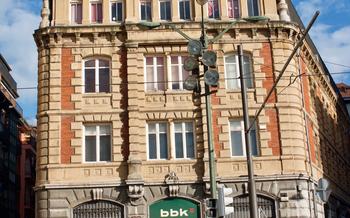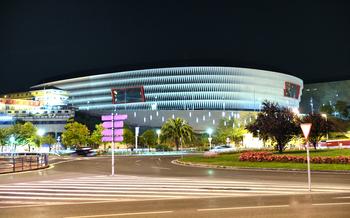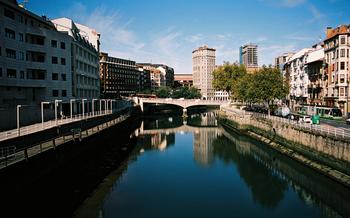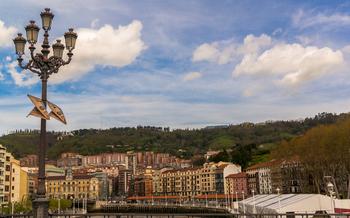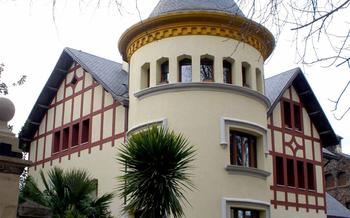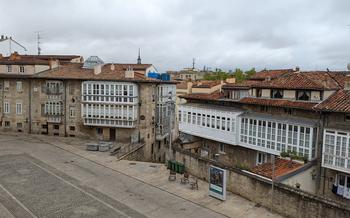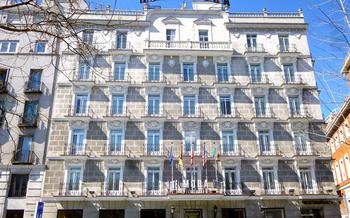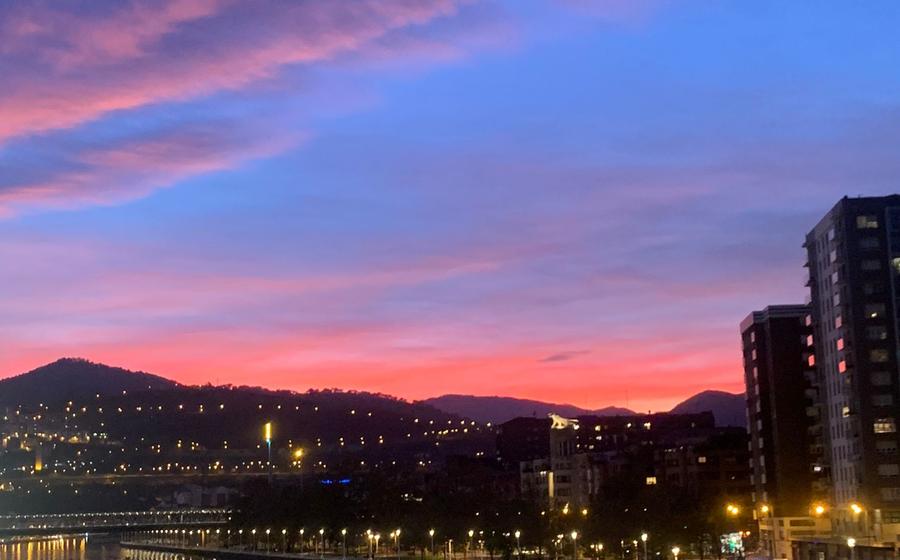
Durango Historical Museum
- The Durango Historical Museum: A Journey Through Time
- Unveiling the Past: Exploring the Museum's Exhibitions
- A Glimpse into Basque Culture and Heritage
- Bilbao's Artistic Legacy: A Showcase of Masterpieces
- The Museum's Educational Programs: Engaging with History
- Tracing the Footsteps of History: A Journey Through Durango
- The Museum's Architectural Charm: A Blend of Styles
- Behind the Scenes: A Peek into the Museum's Operations
- A Symbol of Resilience: The Museum's Role in Preserving Heritage
- The Museum's Library: A Treasure Trove of Knowledge
- Bilbao's Vibrant Cultural Scene: A City of Art and Culture
- Planning Your Visit: Essential Information for Travelers
- Bilbao's Gastronomic Delights: A Culinary Adventure
- Transportation Options: Getting to the Durango Historical Museum
- Insider Tip: Uncovering Hidden Gems in Durango
The Durango Historical Museum: A Journey Through Time
At the heart of the vibrant city of Bilbao, nestled amidst the bustling streets and modern architecture, lies a treasure trove of history and culture, waiting to be explored. The Durango Historical Museum invites visitors to embark on a captivating journey through the annals of time, delving into the rich heritage of the Basque Country and the city of Bilbao itself.
Housed within a magnificent 17th-century building, the Durango Historical Museum stands as a testament to the city's enduring spirit and enduring legacy. Its impressive facade, adorned with intricate carvings and ornate balconies, hints at the wealth of stories and artifacts that lie within.
The museum's collection spans centuries, encompassing a diverse array of exhibits that showcase the region's unique identity and contributions to global history. From ancient artifacts and medieval manuscripts to contemporary artwork and interactive displays, the museum offers a multidimensional experience that captivates and educates visitors of all ages.
Unveiling the Past: Exploring the Museum's Exhibitions
The Durango Historical Museum houses a diverse array of exhibits that transport visitors back in time, shedding light on the rich history and cultural heritage of the Basque region. Permanent exhibits form the cornerstone of the museum's collection, showcasing artifacts, documents, and multimedia displays that narrate the story of Durango from its humble beginnings to its present-day status as a vibrant cultural hub.
Temporary exhibitions, often organized in collaboration with renowned institutions and scholars, bring fresh perspectives and insights into specific aspects of Basque history, art, and culture. These exhibitions feature a rotating selection of artworks, historical objects, and interactive installations that engage visitors and encourage deeper exploration.
Interactive displays and thematic tours further enhance the museum experience, providing visitors with hands-on opportunities to learn about Basque traditions, customs, and daily life. Guided tours led by knowledgeable docents offer a deeper dive into the museum's collection and provide personalized insights into the stories behind the artifacts. These tours are available in multiple languages and can be tailored to suit the interests and needs of different groups.
A Glimpse into Basque Culture and Heritage
The Durango Historical Museum offers a unique opportunity to delve into the rich tapestry of Basque culture and heritage. The museum's exhibits showcase the history, traditions, customs, and gastronomy of the Basque people, providing visitors with a deeper understanding of this vibrant and unique culture.
One of the highlights of the museum is its collection of artifacts that tell the story of Basque history and traditions. Visitors can learn about the region's ancient origins, its struggles for independence, and its contributions to the world. The museum also houses a collection of traditional Basque clothing, tools, and household objects, offering a glimpse into the everyday life of the Basque people.
Basque gastronomy is another highlight of the museum. Visitors can learn about the region's culinary traditions, which are renowned for their use of fresh, local ingredients and simple, yet flavorful dishes. The museum's exhibits feature traditional Basque recipes, cooking demonstrations, and tastings, allowing visitors to experience the flavors of the Basque Country firsthand.
The museum also explores contemporary Basque culture, showcasing the region's vibrant art, music, and literature. Visitors can admire works by renowned Basque artists, listen to traditional Basque music, and learn about the region's literary heritage. Through its exhibits and programs, the Durango Historical Museum offers a comprehensive and engaging journey into the heart of Basque culture and heritage.
Bilbao's Artistic Legacy: A Showcase of Masterpieces
Bilbao's artistic legacy is deeply intertwined with the Durango Historical Museum, which houses a significant collection of paintings, sculptures, and other works of art that reflect the city's rich cultural heritage. Among the notable works in the museum's collection are paintings by renowned Basque artists such as Ignacio Zuloaga, Aurelio Arteta, and Darío de Regoyos. These masterpieces showcase the vibrant colors, expressive brushstrokes, and unique perspectives that characterize Basque art.
The museum also features an impressive collection of sculptures, including works by local artists such as José María Basterra and Quintín de Torre. Their sculptures depict scenes from Basque history and mythology, capturing the essence of the region's cultural identity. In addition to Basque artists, the museum also houses works by international masters such as El Greco, Francisco de Goya, and Pablo Picasso, demonstrating the city's appreciation for diverse artistic styles and influences.
Throughout the year, the museum organizes special exhibitions that showcase specific themes or periods in art history. These exhibitions often feature works from private collections or international museums, allowing visitors to experience a wider range of artistic expressions. The museum's commitment to promoting and preserving Bilbao's artistic legacy makes it a must-visit destination for art enthusiasts and anyone interested in exploring the city's cultural heritage.
The Museum's Educational Programs: Engaging with History
The Durango Historical Museum is dedicated to fostering a deeper understanding of the region's past through a variety of educational programs designed for visitors of all ages.
Workshops and seminars are regularly organized, inviting experts and historians to share their knowledge on specific aspects of Basque history, culture, and heritage. These interactive sessions provide participants with an opportunity to engage in discussions, ask questions, and gain new insights into the region's rich past.
Guided tours specifically tailored for school groups are available, allowing students to embark on a journey through time as they explore the museum's exhibits and learn about the region's significant historical events and cultural traditions. Educational resources such as lesson plans, worksheets, and multimedia presentations are provided to teachers to enhance the learning experience for their students.
Families are also welcome to participate in fun and engaging activities designed to make history come alive for children of all ages. Interactive exhibits, storytelling sessions, and hands-on workshops encourage families to explore the museum together, fostering a love for learning and creating lasting memories.
Tracing the Footsteps of History: A Journey Through Durango
Beyond the walls of the Durango Historical Museum, the town of Durango itself is a treasure trove of historical landmarks and cultural heritage. A stroll through its cobbled streets reveals a blend of medieval and modern architecture, with ancient churches, traditional Basque houses, and contemporary buildings harmoniously coexisting.
Durango's Historical Center
The heart of Durango's historical legacy lies in its medieval quarter, declared a Conjunto Histórico-Artístico (Historic-Artistic Site). Here, visitors can admire the 13th-century Santa María de Uribarri Church, a Gothic masterpiece with an impressive altarpiece. The Town Hall, with its Renaissance-style façade, is another architectural highlight.
Durango's Walls and Gates
The town's medieval fortifications, dating back to the 13th century, are a testament to Durango's strategic importance. The well-preserved walls feature several gates, including the iconic San Pedro Gate, which leads to the Old Town.
The Zabala Palace
This 18th-century Baroque palace, located in the Old Town, is a stunning example of Basque architecture. It currently houses the Durango Tourist Office, providing visitors with information and guidance on exploring the town and its surroundings.
Guided Walking Tours
To delve deeper into Durango's history and culture, visitors can join guided walking tours offered by local experts. These tours provide insights into the town's significant landmarks, hidden gems, and local traditions.
Self-Guided Exploration
For those who prefer to explore at their own pace, a self-guided walking tour is an excellent option. Several maps and guidebooks are available to help visitors navigate the town's historical highlights.
Local Legends and Anecdotes
Durango is steeped in local legends and anecdotes that add a touch of charm and mystery to the town's historical narrative. Visitors can uncover these stories through conversations with locals, guided tours, or by reading local publications.
The Museum's Architectural Charm: A Blend of Styles
The Durango Historical Museum is housed in a magnificent building that showcases a blend of architectural styles, reflecting the rich history of the city. The building was initially constructed in the 16th century as a military fortress, featuring sturdy walls and defensive elements. Over the centuries, it underwent several renovations and expansions, resulting in the incorporation of Renaissance, Baroque, and Neoclassical architectural elements.
The main façade of the museum exhibits a striking Renaissance-style design, characterized by symmetry and elegant ornamentation. The symmetrical arrangement of windows and doors, along with the intricate carvings and moldings, adds a touch of sophistication to the building's exterior. The interior courtyard features a beautiful Renaissance arcade, supported by slender columns and arches.
The Baroque influence is evident in the elaborate decorations and embellishments found throughout the museum. The grand staircase, with its ornate balustrade and decorative ceiling frescoes, is a testament to the Baroque period's artistic sensibilities. The Baroque style also manifests in the intricate carvings and sculptures adorning the building's exterior and interior.
During the 19th century, the museum underwent a major renovation, resulting in the incorporation of Neoclassical elements. The addition of a new wing to the building showcased Neoclassical features, such as clean lines, geometric forms, and restrained ornamentation. The Neoclassical influence brought a sense of order and balance to the overall architectural composition.
The restoration and preservation efforts undertaken by the museum have ensured that these diverse architectural styles coexist harmoniously, creating a unique and captivating historical landmark. The Durango Historical Museum stands as a testament to the city's rich architectural heritage, inviting visitors to explore the fascinating stories and artistic expressions that have shaped its identity over the centuries.
Behind the Scenes: A Peek into the Museum's Operations
The Durango Historical Museum operates with precision and dedication, ensuring the preservation and accessibility of its invaluable collections. Curatorial practices are meticulously followed, with experts authenticating, cataloging, and maintaining each artifact. Conservation techniques are employed to safeguard the integrity of delicate objects, utilizing state-of-the-art technology and time-honored methods.
Research and documentation are integral to the museum's operations, shedding light on the historical significance of its holdings. Scholars and researchers delve into the museum's archives, unearthing new insights and contributing to the body of knowledge about Basque history and culture. Educational initiatives are a cornerstone of the museum's mission, fostering engagement and learning among visitors of all ages. Workshops, seminars, and guided tours are meticulously crafted to provide immersive experiences that bring the past to life.
A Symbol of Resilience: The Museum's Role in Preserving Heritage
The Durango Historical Museum stands as a steadfast symbol of resilience, playing a pivotal role in preserving and showcasing the rich heritage of the Basque Country. In the face of societal changes and the passage of time, the museum has remained committed to safeguarding the unique cultural identity of the region.
Throughout its existence, the museum has faced numerous challenges, including limited resources, political turmoil, and changing cultural trends. However, it has consistently persevered, relying on the unwavering support of the local community. The museum's success is a testament to the enduring spirit of the Basque people and their determination to preserve their cultural legacy.
The museum's ongoing efforts have been instrumental in raising awareness about Basque culture and history, both within the region and beyond. It has become a repository of knowledge and a place where people from all walks of life can come to learn about and appreciate the Basque heritage.
Looking to the future, the museum is committed to continuing its mission of preservation and education. With plans to expand its collections, host more exhibitions, and develop innovative educational programs, the Durango Historical Museum is poised to remain a vital force in safeguarding and celebrating the unique cultural heritage of the Basque Country.
The Museum's Library: A Treasure Trove of Knowledge
The Durango Historical Museum houses a remarkable library that serves as a repository of knowledge and a valuable resource for researchers, historians, and students. This treasure trove of information boasts a comprehensive collection of rare books, manuscripts, and documents that shed light on the rich history and cultural heritage of the Basque Country.
Among the library's prized possessions are ancient texts, chronicles, and manuscripts that provide invaluable insights into the region's past. These rare documents offer a glimpse into the lives, customs, and traditions of the Basque people, allowing visitors to delve deeper into the region's unique identity.
In addition to its historical collection, the library also houses an extensive collection of specialized books, journals, and articles on a wide range of topics related to Basque culture, history, art, and society. These resources cater to researchers, scholars, and students seeking to explore specific aspects of Basque heritage in greater depth.
The library's facilities are designed to facilitate research and learning. Comfortable reading areas, state-of-the-art research tools, and access to online databases create a conducive environment for study and contemplation. The library staff is knowledgeable and helpful, providing assistance to visitors in locating materials and conducting research.
The Durango Historical Museum's library is not just a repository of knowledge; it is a living and dynamic space that fosters intellectual curiosity and encourages a deeper understanding of Basque history and culture. It serves as a bridge between the past and the present, preserving the region's heritage while contributing to the ongoing exploration of its rich traditions.
Bilbao's Vibrant Cultural Scene: A City of Art and Culture
Bilbao has undergone a remarkable transformation in recent decades, evolving into a vibrant cultural hub that attracts visitors from around the world. The city's urban renewal projects, spearheaded by the construction of the Guggenheim Museum, have played a pivotal role in this transformation. Once a neglected industrial city, Bilbao has reinvented itself as a cultural powerhouse, showcasing a diverse array of museums, galleries, and cultural venues.
In addition to the Durango Historical Museum, Bilbao boasts a wealth of other cultural attractions. The Guggenheim Museum, with its iconic titanium-clad exterior, houses an impressive collection of modern and contemporary art, including works by renowned artists such as Andy Warhol, Roy Lichtenstein, and Antoni Tàpies. The Bilbao Fine Arts Museum, housed in a stately 19th-century building, showcases a comprehensive collection of Spanish and Basque art from the Middle Ages to the present day.
Bilbao's cultural scene extends beyond its museums and galleries. The city hosts a variety of cultural events and festivals throughout the year, including the Bilbao International Film Festival, the Bilbao BBK Live music festival, and the Aste Nagusia, a week-long festival featuring traditional Basque music, dance, and gastronomy.
Bilbao's unique artistic identity is further reflected in its public art installations, which can be found throughout the city. Sculptures by renowned artists such as Eduardo Chillida and Jorge Oteiza grace the streets and plazas of Bilbao, adding a touch of contemporary flair to the city's historic architecture.
With its vibrant cultural scene, Bilbao has established itself as a must-visit destination for art and culture enthusiasts. The city's unique blend of traditional Basque culture and contemporary artistic expression offers visitors an unforgettable cultural experience.
Planning Your Visit: Essential Information for Travelers
If you're planning a visit to the Durango Historical Museum, here's some essential information to ensure a smooth and enjoyable experience:
-
Museum Hours and Admission Fees: The museum is typically open from 10:00 AM to 6:00 PM, Tuesday through Sunday. Admission fees vary depending on the type of ticket and any special exhibitions. Check the museum's website for current pricing and ticketing options.
-
Accessibility and Facilities: The museum is wheelchair accessible and offers a range of facilities for visitors, including restrooms, a cloakroom, and a cafeteria. Guided tours in different languages are available upon request, and audio guides are also provided for a more immersive experience.
-
Guided Tour Options: To delve deeper into the museum's collections and history, guided tours are highly recommended. Tours are led by knowledgeable guides who can provide insights and anecdotes that bring the exhibits to life. Advance booking is advisable to secure your spot.
-
Tips for Making the Most of Your Visit: Allow at least two to three hours to fully explore the museum's permanent and temporary exhibitions. Take advantage of the interactive displays and multimedia presentations to engage with the exhibits in a dynamic way. Don't forget to visit the museum shop for unique souvenirs and publications related to Basque history and culture.
Bilbao's Gastronomic Delights: A Culinary Adventure
Bilbao, renowned for its vibrant cultural scene, also boasts a thriving culinary landscape. Basque cuisine, with its distinct flavors and innovative techniques, has gained global recognition and is celebrated for its use of fresh, local ingredients and traditional recipes.
When visiting the Durango Historical Museum, take the opportunity to indulge in some of the city's gastronomic delights. Explore the nearby streets and discover charming restaurants offering a range of Basque specialties. Try the succulent "pintxos," small plates of savory snacks, often served at local bars, or savor a traditional Basque meal at one of the city's many renowned restaurants.
Must-try dishes include "bacalao al pil pil," a codfish dish cooked in a rich garlic and olive oil sauce, and "txuleton," a grilled rib steak that showcases the region's exceptional beef. Don't miss the chance to sample local cheeses, such as Idiazabal and Ossau-Iraty, and indulge in traditional desserts like Basque cheesecake or "pastel vasco," a sweet pastry filled with custard or fruit.
Enhance your culinary journey by joining a guided food tour or attending a cooking workshop, where you can learn the secrets of Basque cuisine and create your own delicious dishes. Bilbao's vibrant gastronomic scene promises an unforgettable culinary adventure, complementing the cultural and historical experiences offered by the Durango Historical Museum.
Transportation Options: Getting to the Durango Historical Museum
Reaching the Durango Historical Museum is a breeze, with a variety of transportation options available. For those who prefer public transportation, several bus lines stop nearby, making it easy to access the museum from different parts of the city. The museum is also within walking distance from the Durango train station, offering a scenic and convenient option for visitors arriving by rail.
For those driving, there are ample parking spaces available in the vicinity of the museum. The museum's central location ensures easy access from major roads and highways. Visitors with disabilities will find designated accessible parking spaces close to the museum entrance, ensuring a hassle-free visit.
In addition to public transportation and driving, visitors can also opt for alternative transportation options to get to the museum. Bike rental services are available in Bilbao, allowing visitors to explore the city and reach the museum on two wheels. The museum's proximity to the city center also makes it accessible on foot, offering a chance to soak in the vibrant atmosphere of Bilbao while heading to the museum.
Insider Tip: Uncovering Hidden Gems in Durango
Beyond the Durango Historical Museum, the city offers a wealth of hidden gems waiting to be discovered. For a glimpse into local life, visit the bustling Plaza de los Fueros, where you can witness traditional Basque dancing and sample delicious pintxos (Basque tapas) at the surrounding bars. For a unique shopping experience, head to the Durango Artisan Market, where local artists and craftspeople showcase their handmade creations.
If you're interested in exploring the city's natural beauty, take a leisurely stroll along the banks of the Durango River, where you can admire the stunning scenery and spot local wildlife. For a more active adventure, embark on a hike in the nearby Urkiola Natural Park, where you'll be rewarded with breathtaking views of the Basque countryside.
For a truly memorable experience, time your visit to coincide with one of Durango's many festivals. The most famous is the Durango Basque Festival, held annually in July, which celebrates Basque culture and traditions with music, dance, and traditional Basque sports competitions.
Whether you're a history buff, a nature lover, or simply looking for a unique travel experience, Durango has something to offer every visitor. So, take the time to explore beyond the Durango Historical Museum and discover the hidden gems that make this city so special.

